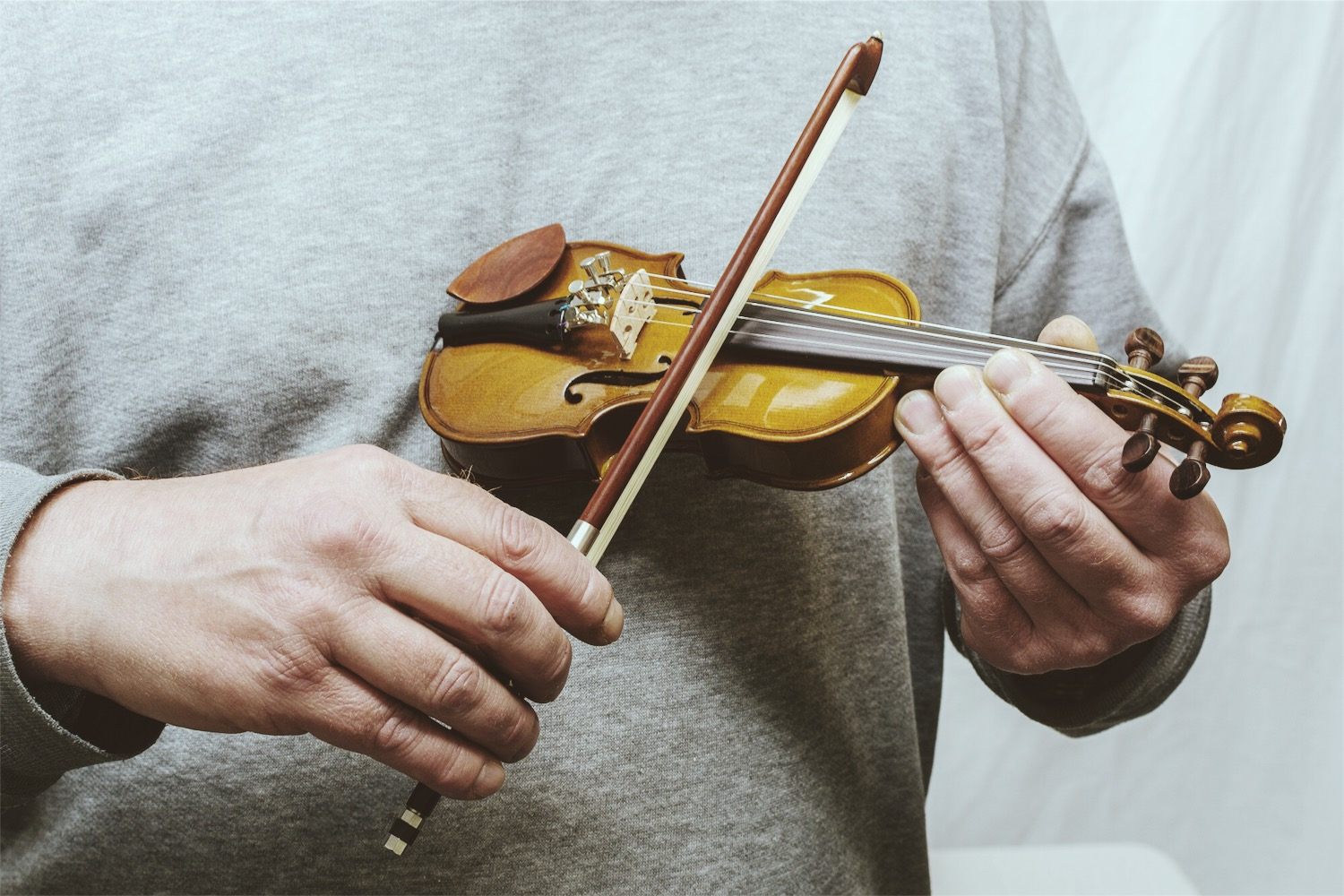The World’s Smallest Violin and the Tiny Musicians Who Play It
These mini musical instruments are very carefully crafted.

The world’s tiniest violin is an honest-to-goodness four-stringed, spruce-and-maple music-maker sized for the diaper-wearing preschool set—horsehair bow included. From tailpiece to tip of its scroll, the whole instrument clocks in just under a foot. And it is adorable. (For comparison, a full-size violin is 23 inches long: behemoth.)
It’s called a 1/64 violin—or “the sixty-fourth” according to luthiers, who make stringed instruments. Its slightly larger siblings are the 1/32 violin (13.4 inches long) and the 1/16 (15 inches). (The fraction comes from measuring the volume inside the instrument’s body.) Elissa Krebs, a Utah-based violin teacher and author of the Diaper Class Blog: Violin for Babies says they’re so small, they fit in a purse.
At the start of her career, Krebs, a mother of two—and soon to be three—miniature violinists, tried unsuccessfully to teach the violin to three and four year olds. Yet when she became a mother, she found herself wanting to try again—this time even earlier. “I was really obsessed with parenting. I read every single parenting manual I could find … When my little boy turned two, I was just like, how can I teach him violin?”

Answer? With arts and crafts. Krebs got a butter box, cut it in half, wrapped it in brown paper, taped a paint stirrer down its middle, and drew a violin on it.
The “box violin” is a fairly standard choice for parents who are not aware of tiny violins. (When this writer wanted to learn the cello at age five, she was handed a doll trunk and a stick.) It’s also standard for parents who are aware of tiny violins but don’t trust their toddlers to differentiate between a musical instrument and a Tonka truck. Many teachers, too, think the box is best for teaching “set-up,” how to hold the instrument. Krebs was the latter two.
Her son caught onto his early lessons quickly—a little too quickly. Before his body was big enough for a 1/32 violin, she needed to graduate him to a proper noise-making instrument. “I knew there were 1/64ths out there, but I didn’t know where to find one. The violin shop that I use for all my students didn’t have anything that small.” Although she forbids her students’ parents from getting violins online (“You just don’t buy one off of eBay!”), Krebs, desperate, had to. “So I’m Googling and I found this shop set up from China. I don’t even know what it was, but for $50 they had a 1/64th size.” She ordered it.
“And it turned out, it’s basically a piece of garbage. It doesn’t really play.”
Although full-size violins have existed since the 1500s, it wasn’t until Dr. Shinichi Suzuki founded his musical pedagogy in the 20th century that anyone thought to outfit a tiny human with a real instrument.

A child can learn music the same way she learns language, Suzuki believed: by ear, by immersion, and by imitation. Musical development should begin around the same time as language—which is to say, very, very young. “Mother-tongue approach,” he called his method. Many Suzuki violin instructors today say that yes, they’ve heard of colleagues who have worked with kids as young as two, but sigh when asked if they would take on the challenge themselves. Contemporary Suzuki “Pre-Twinkle” programs are filled with kids closer to age four. Most Pre-Twinklers saw their open strings on a 1/16th.

As Dr. Suzuki and his method were becoming known across Europe and North America in the late ‘60s and early ‘70s, Stentor Music, a 120-year-old British manufacturer and distributor of stringed instruments, spotted an opportunity to expand—by shrinking. “My father really built [our] violin business into what it is today,” says Luke Doughty, the Product Manager at Stentor and heir apparent to this family business. Recognizing the budding demand for extra-small violins, the elder Mr. Doughty partnered with luthiers, string makers, and violin teachers to hack the 1/32 and 1/64 sizes. In the 1980s, Stentor’s tiny violins went to market.

Today there are about 15 craftsmen in Stentor’s Taixing, China, factory trained to build these tiniest of instruments. By hand, they shape little planes of wood and whittle miniature F-holes and carve absurdly small bespoke wood bridges. They even lay purfling—inlaid decorative lines— in perfect parallel around the sixty-fourth’s edges. It’s a process that requires 80-plus man hours.
Beyond the cute factor, there’s not much reward. Stentor prices its smallest violins around $160. What parent would pay more for something a toddler will grow out of, or break, in months? So even though Stentor is the biggest player in the tiny-violin game, they produce just a few hundred each year. Distributed globally, real sixty-fourths are rare birds indeed.
“An eBay”—not a sixty-fourth—is what we should call the $50 job Elissa Krebs wound up with. That’s what violin dealer Harold Hagopian said in a shoebox of a garden apartment on Manhattan’s Upper West Side. This is the shop out of which Hagopian rents his massive inventory of stringed instruments. He stocks 1/16ths galore and plenty of 1/32nds. But he only has one sixty-fourth.

A Juilliard-trained violinist, Hagopian founded Virtuoso Resources eight years ago when he faced the same dilemma as Krebs: a tiny violinist for a son, but only eBays in the ether. eBays, he explained, are made of plywood, spray painted brown-ish, and lacquered in a slop of polyurethane. “You can drop it and everything and it won’t break. But there’s absolutely no sound.” In the height of industry invective, an eBay is this: a toy.
Unlike the real deal.
Hagopian lifted his sixty-fourth out of its case. He explained that his smallest violin is not a Stentor, but comes from his own label. Like Stentor’s instruments, however, it was crafted by hand in China from carefully sourced woods and varnishes.
It looks, feels, and smells just like a full-size violin. In the squeaky, unsure timbre of the tiniest violinists who play it, it even, sort of, sings.

















Follow us on Twitter to get the latest on the world's hidden wonders.
Like us on Facebook to get the latest on the world's hidden wonders.
Follow us on Twitter Like us on Facebook